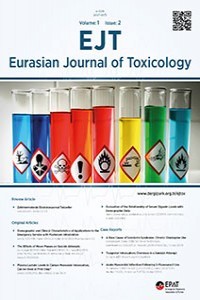
Eurasian Journal of Toxicology
Yazarlar: Gülşah ÇIKRIKÇI IŞIK, Yunsur ÇEVİK
Konular:Acil Tıp
Anahtar Kelimeler:Cyanide,Poisoning,Antidotes,Hydroxocobalamin,Nitrites
Özet: Cyanide is a rapidly acting, lethal poison that interfere with mitochondrial oxygen utilization. It has many natural, industrial and even household sources. Most common cause of cyanide poisoning is smoke inhalation. Intravenous and inhaled cyanide exposures produce more rapid onset of signs and symptoms than does oral or transdermal ingestions. The clinical presentation varies with the physicochemical form of cyanide, the dose, route of entry, co-toxicants delay since exposure. Central nervous system and cardiovascular system dysfunction are most prominent; also there are nonspecific sings such as nausea, vomiting, headache, dizziness, confusion, coma, seizures, dilated pupils, and abnormal vital signs. Cyanide toxicity expected to have two characteristic symptoms theoretically; those are cherry-red skin and odor of bitter almond from the victims’ breath. Cyanide-poisoned patients have an elevated blood lactate concentration. A cutoff point of 8 mmol/L lactate level should be suggested as a diagnostic indicator of cyanide toxicity. Blood cyanide level is the confirmatory test for cyanide poisoning and but it is not routinely performed in most hospitals and may not correlate with toxicity; therefore it cannot guide treatment. The treatment of patients poisoned with cyanide includes supportive care and adjunctive antidotal therapy. Cyanide toxicity is rapidly lethal, so clinicians must stabilize the patient’s airway, breathing and circulation first. Antidotal treatment of cyanide poisoning involves three strategies which are binding of cyanide, induction of methemoglobinemia, and use of sulfur donors. Hydroxocobalamin and dicobalt edetate are direct cyanide binding antidotes. In general hydroxocobalamin as first-line antidotal therapy is effective and safe in acute cyanide poisoning. Amily nitrite, sodium nitrite and 4dimethylaminophenol are the antidotes that induce methemoglobinemia. Nitrites are not suitable for fire victims, and those with poor cardiopulmonary reserve. Sodium thiosulfate is a sulfur donor antidote. Recommendation for antidotal treatment strategies in case of cyanide poisoning depends on the availability of antidotes and accuracy of the diagnosis.